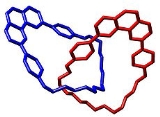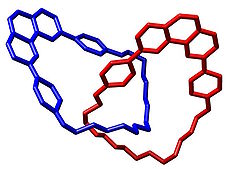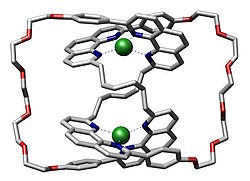
Jean Pierre Sauvage
Encyclopedia


Supramolecular chemistry
Supramolecular chemistry refers to the area of chemistry beyond the molecules and focuses on the chemical systems made up of a discrete number of assembled molecular subunits or components...
.
Sauvage was born in Paris in 1944 and obtained his Ph.D. from the University of Louis Pasteur under the supervision of J.-M. Lehn
Jean-Marie Lehn
Jean-Marie Lehn is a French chemist. He received the Nobel Prize together with Donald Cram and Charles Pedersen in 1987 for his work in Chemistry, particularly his synthesis of the cryptands...
. During his PhD work, he contributed to the first syntheses of the cryptand
Cryptand
Cryptands are a family of synthetic bi- and polycyclic multidentate ligands for a variety of cations. The Nobel Prize for Chemistry in 1987 was given to Donald J. Cram, Jean-Marie Lehn, and Charles J. Pedersen for their efforts in discovering and determining uses of cryptands and crown ethers,...
ligands. After postdoctoral research with M. L. H. Green, he returned to Strasbourg, where he is now emeritus professor.
A prolific scientist, he has worked in several areas including electrochemical reduction of CO2 and models of the photosynthetic
Photosynthesis
Photosynthesis is a chemical process that converts carbon dioxide into organic compounds, especially sugars, using the energy from sunlight. Photosynthesis occurs in plants, algae, and many species of bacteria, but not in archaea. Photosynthetic organisms are called photoautotrophs, since they can...
reaction center. A large theme of his work is molecular topology
Topoisomer
Topoisomers or topological isomers are molecules with the same chemical formula and stereochemical bond connectivities but different topologies. Examples of molecules for which there exist topoisomers include DNA, which can form knots, and catenanes...
, specifically mechanically-interlocked molecular architectures
Mechanically-interlocked molecular architectures
Mechanically interlocked molecular architectures are connections of molecules not through traditional bonds, but instead as a consequence of their topology. This connection of molecules is analogous to keys on a key chain loop. The keys are not directly connected to the key chain loop but they...
. He has described syntheses of catenane
Catenane
A catenane is a mechanically-interlocked molecular architecture consisting of two or more interlocked macrocycles. The interlocked rings cannot be separated without breaking the covalent bonds of the macrocycles. Catenane is derived from the Latin catena meaning "chain"...
s and molecular knot
Molecular knot
In chemistry, a molecular knot, or knotane, is a mechanically-interlocked molecular architecture that is analogous to a macroscopic knot. A molecular knot in a trefoil knot configuration is chiral, having at least two enantiomers. Examples of naturally formed knotanes are DNA and certain proteins....
s based on coordination complexes.
He was elected a correspondent member of the French Academy of Sciences
French Academy of Sciences
The French Academy of Sciences is a learned society, founded in 1666 by Louis XIV at the suggestion of Jean-Baptiste Colbert, to encourage and protect the spirit of French scientific research...
on March 26, 1990, and a member on November 24, 1997. He is currently Professor at the Université Louis Pasteur, Strasbourg
Strasbourg
Strasbourg is the capital and principal city of the Alsace region in eastern France and is the official seat of the European Parliament. Located close to the border with Germany, it is the capital of the Bas-Rhin département. The city and the region of Alsace are historically German-speaking,...
.
External links
- A Chem Soc Rev themed issue dedicated to Professor Jean-Pierre Sauvage on the occasion of his 65th birthday. Includes The master of Chemical Topology, an editorial by Professor J Fraser Stoddart about the life and work of Professor Sauvage

